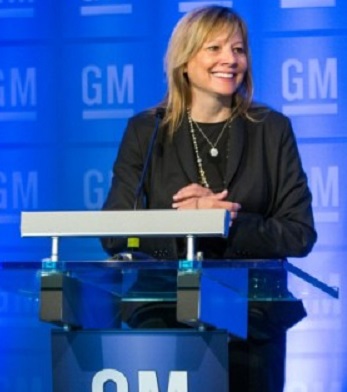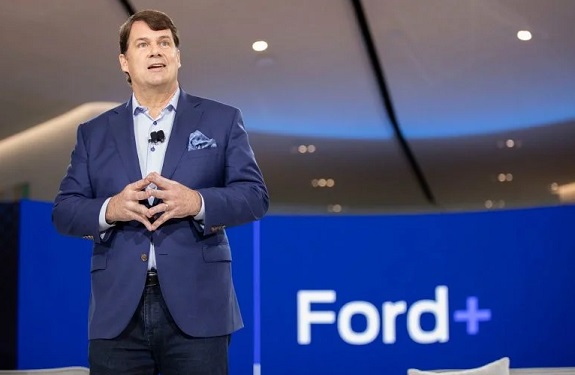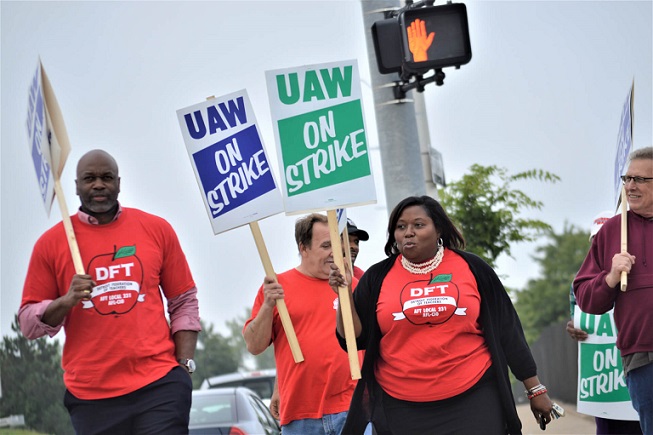Soaring CEO Pay Commands Spotlight In UAW Strike Against Big 3 US Automakers!
FEATURED PHOTO: STELLANTIS CEO CARLOS TAVARES
ABCNews.go.com, By Max Zahn, Posted September 21st 2023
Autoworkers have demanded wage increases that match recent hikes in CEO pay.
A strike launched by thousands of autoworkers against the Big 3 U.S. automakers early Friday morning has spotlighted an issue raised by employees across the economy: The gap between CEO and worker pay.
The United Auto Workers, or UAW, has demanded a 46% raise for workers over the next four years. The proposed pay increase slightly exceeds the combined 40% increase in CEO compensation over the past four years at the Big 3 — General Motors, Ford and Stellantis, which owns Jeep and Chrysler, the union said.
Over that same period, the average pay for autoworkers at those companies rose 6%, the union said.

“While the Big 3 executives and shareholders got rich, UAW members, the workers, got left behind,” UAW President Shawn Fain said on Facebook Live last month, signaling a message that has pervaded his public statements in recent weeks.
The two sides remain far apart on the issue of pay increases. General Motors and Ford put forward proposals on Thursday that offer workers a 20% pay increase over the 4-year duration of the agreement; the latest offer from Stellantis includes a pay increase of 17.5% over the duration of the contract.
In a statement to ABC News, a General Motors spokesperson criticized the strike and touted the pay hike offered by the company.
“We are disappointed by the UAW leadership’s actions, despite the unprecedented economic package GM put on the table, including historic wage increases and manufacturing commitments,” the spokesperson said. “We will continue to bargain in good faith with the union to reach an agreement as quickly as possible for the benefit of our team members, customers, suppliers and communities across the U.S.”
Ford did not immediately respond to ABC News’ request for comment on the CEO-to-worker pay gap.
On Friday, Ford laid off 600 workers who assemble cars at a plant in Michigan, the company told ABC News in a statement. Workers in the paint department at a nearby plant are out on strike, leaving the assembly workers without adequate parts, since the parts require paint before they can be put together into cars, the company said.
“Our production system is highly interconnected, which means the UAW’s targeted strike strategy will have knock-on effects for facilities that are not directly targeted for a work stoppage,” Ford said.
Ford President and CEO Jim Farley said last week in a statement, “Overall, this offer is significantly better than what we estimate workers earn at Tesla and foreign automakers operating in the U.S.”
Stellantis declined ABC News’ request for comment.

While the CEOs at the Big 3 U.S. automakers enjoyed a significant increase in combined compensation over the past four years, the pay hikes among the chief executives differed substantially, according to a data analysis from research firm Equilar reviewed by ABC News.
Ford paid Farley 21% more last year than the company’s previous CEO received in 2018; while General Motors paid CEO Mary Barra 34% more over that period, the data showed.
However, Stellantis CEO Carlos Tavares received about 24% less last year than his predecessor did in 2018, the data found.
Equilar identified a different total compensation for Tavares than the UAW because Equilar adjusted the reporting methodology for the Amsterdam-based company to match the one undertaken by Ford and General Motors, Equilar director of research Courtney Yu told ABC News in a statement.
“These workers are physically making the cars every day, watching the cars get built and seeing their actual contribution to the productivity of the firm,” Lisa LaViers, a professor at Tulane University’s Freeman School of Business who studies executive pay and its effect on workers, told ABC News.
“When it’s the case that they’re seeing their CEO — who obviously doesn’t make the cars — benefit from their physical manual labor at a higher rate than they’re benefitting from it, you can understand how that hurts,” LaViers added.

The disparity between the rate of pay increases in recent years between workers and CEOs at the Big 3 U.S. automakers in recent years has helped contribute to a widening of the gap in pay between the companies’ top executives and their typical workers.
Last year, Barra, of General Motors, received compensation totaling $29 million while a median worker at the company received about $80,000, amounting to a ratio of 362-to-1, Securities and Exchange Commission filings show.
Farley, of Ford, received compensation last year totaling $21 million while a median employee at the company received about $75,000, resulting in a ratio of 281-to-1, the filings show.
The surge in CEO pay across the U.S. economy owes in part to the overall growth in size of major U.S. corporations, which increases the scale of compensation on offer for a chief executive, LaViers of Tulane University said.
In addition, strong CEOs command high compensation because they have an outsized impact on the success of a given company and, in turn, are in high demand, LaViers added.
“You can think about it like an NFL quarterback,” LaViers said. “Tom Brady is worth a lot of money and Tom Brady has shown it. These superstar CEOs are similar.”
When a company provides a large compensation package for its CEO, however, the firm can still offer pay raises for its workers, LaViers added.
“What’s interesting is that the United Auto Workers is not negotiating for lower CEO pay,” LaViers said. “They don’t care what the CEO gets paid, necessarily, as long as they are also getting paid commensurate with them.”








